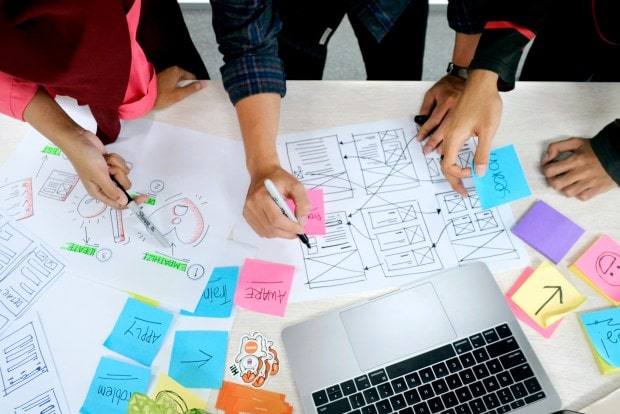In today’s fast-paced world, businesses and organizations encounter increasingly complex challenges that demand innovative solutions. Design thinking has emerged as a powerful methodology for tackling these intricate problems by placing human needs and experiences at the center of the problem-solving process. In this article, we delve into the essence of design thinking, its core principles, and how it empowers teams to generate creative solutions that resonate with users.
Understanding Design Thinking
At its core, design thinking is a problem-solving approach that prioritizes empathy, creativity, and experimentation. Unlike traditional problem-solving methods, which often rely on linear processes and predefined solutions, design thinking embraces ambiguity and encourages iterative exploration. Originating from the field of design, this methodology has found widespread adoption across various industries, including technology, healthcare, education, and beyond.
The Core Principles
Design thinking is guided by several fundamental principles that shape its methodology:
1. Empathy: The foundation of design thinking lies in understanding the needs, desires, and challenges of the people for whom solutions are being developed. By empathizing with users, designers gain valuable insights that inform the creation of meaningful and relevant solutions.
2. Human-Centeredness: Design thinking places humans at the heart of the problem-solving process. Rather than focusing solely on technical requirements or business objectives, it prioritizes the experiences and perspectives of end-users, ensuring that solutions address real-world needs and preferences.
3. Iterative Process: Design thinking embraces experimentation and iteration as essential components of the creative journey. Instead of pursuing a single, definitive solution from the outset, teams explore multiple possibilities, gather feedback, and refine their ideas through continuous cycles of prototyping and testing.
4. Collaboration: Effective design thinking relies on interdisciplinary collaboration, bringing together individuals with diverse backgrounds, skills, and perspectives. By fostering a culture of collaboration, teams can leverage the collective intelligence of their members to generate innovative solutions that transcend individual expertise.
The Design Thinking Process
While design thinking is inherently flexible and adaptable, it typically follows a structured process comprising several distinct phases:
1. Empathize: In this initial phase, designers immerse themselves in the users’ world to gain a deep understanding of their needs, motivations, and pain points. This involves conducting interviews, observations, and other research activities to uncover insights that inform subsequent stages of the process.
2. Define: With insights gathered during the empathy phase, designers define the problem statement that serves as the focal point for ideation and solution development. This step involves synthesizing research findings to identify key challenges and opportunities that shape the design brief.
3. Ideate: In the ideation phase, teams generate a wide range of potential solutions through brainstorming, sketching, and other creative techniques. The goal is to explore diverse perspectives and unlock innovative ideas that address the problem statement from multiple angles.
4. Prototype: Once promising ideas have been identified, designers create low-fidelity prototypes that embody different aspects of the proposed solutions. These prototypes serve as tangible representations that allow teams to gather feedback, iterate rapidly, and refine their concepts before moving to the next phase.
5. Test: In the final phase of the design thinking process, prototypes are shared with users for evaluation and feedback. This feedback loop provides valuable insights into the viability, usability, and desirability of the solutions, enabling teams to make informed decisions and refine their designs iteratively.
Benefits of Design Thinking
Design thinking offers numerous benefits for organizations seeking to innovate and solve complex problems:
1. User-Centric Solutions: By prioritizing empathy and human-centeredness, design thinking ensures that solutions resonate with users’ needs, preferences, and behaviors, leading to products and services that are more intuitive, engaging, and impactful.
2. Creativity and Innovation: The iterative nature of design thinking encourages experimentation and exploration, fostering a culture of creativity and innovation within teams. By embracing ambiguity and reframing challenges as opportunities for discovery, organizations can unlock new possibilities and break through traditional constraints.
3. Collaborative Culture: Design thinking promotes interdisciplinary collaboration, breaking down silos and fostering cross-functional teamwork. By bringing together individuals with diverse perspectives and skill sets, organizations can leverage the collective intelligence of their teams to tackle complex problems more effectively.
4. Iterative Improvement: Through rapid prototyping and user testing, design thinking enables organizations to validate assumptions, gather feedback, and refine their solutions iteratively. This iterative approach minimizes the risks associated with large-scale implementation and increases the likelihood of success in the marketplace.
Conclusion
In an era defined by rapid change and uncertainty, design thinking offers a powerful framework for navigating complexity and driving innovation. By prioritizing empathy, creativity, and collaboration, organizations can harness the collective intelligence of their teams to develop human-centered solutions that address real-world needs and challenges. Whether designing products, services, or experiences, the principles and practices of design thinking provide a roadmap for unlocking creativity, fostering innovation, and delivering meaningful impact in an ever-evolving world.




